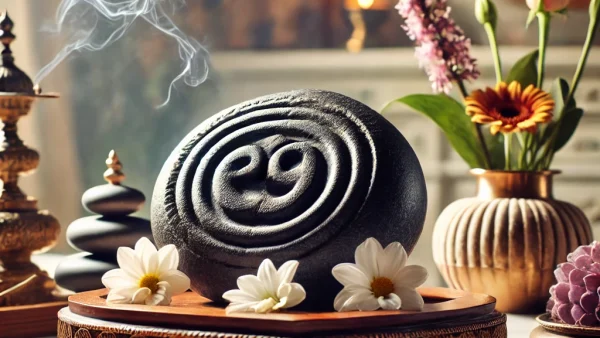Introduction
In the heart of the Himalayas, where the sacred rivers flow and the majestic peaks touch the skies. Lies an ancient treasure revered by Hindus and Buddhists alike: the Shaligram. This sacred stone, believed to be a manifestation of Lord Vishnu. Has captivated the minds and hearts of devotees for millennia. It holds a special place in religious ceremonies, meditation practices, and rituals dedicated to Vishnu and other divine entities. But where exactly are these revered stones found, and why do they carry such spiritual significance?
In this blog, we will delve into the origins of Shaligrams. Explore their cultural and spiritual importance, and unravel the mystery of where these stones can be found. If you’re passionate about Rudraksha, Vishnu, or the profound spiritual traditions of Buddhism and Hinduism. This journey into the world of Shaligrams will resonate deeply.
What Are Shaligrams?
Shaligrams are fossilized ammonite stones, often found in a unique spiral shape, believed to have formed millions of years ago. In Hindu tradition, they are considered sacred embodiments of Lord Vishnu, representing his divine power and the cyclical nature of the universe. Devotees often keep Shaligrams in their homes or temples, using them in daily prayers and rituals, believing that they bring protection, prosperity, and spiritual enlightenment.
What makes Shaligrams particularly fascinating is their natural formation. Each stone is said to carry different marks or “chakras” that represent various avatars of Vishnu. Some Shaligrams have intricate patterns resembling conch shells, lotuses, or even images of Vishnu himself, which are interpreted as divine signs. These stones have deep connections with Rudraksha beads, often worn together for their combined spiritual potency.
Origins in the Vishnu-Purana and Ancient Texts
The story of Shaligrams is intricately tied to the Vishnu-Purana, one of the ancient Hindu scriptures. According to legend, Lord Vishnu resides in the Shaligram as an eternal presence. It is said that Vishnu cursed a demon named Jalandhara, whose body dissolved into the Gandaki River, leaving behind these sacred stones. These scriptures further describe how Shaligrams manifest the essence of Vishnu and hold divine vibrations that transcend time.
Where Are Shaligrams Found?
The Shaligram stones are primarily found along the banks of the Gandaki River, a sacred waterway that flows through the majestic landscapes of Nepal. Nestled in the region of the Kali Gandaki Gorge, near the ancient pilgrimage town of Muktinath, these stones are naturally unearthed from the riverbeds. This region is also known as the Shaligram Kshetra, a place of immense spiritual significance.
The Gandaki River, revered as the living embodiment of Vishnu, is one of the few places in the world where Shaligrams are naturally found. The river, cutting through the Himalayas, flows with incredible force, exposing the fossilized ammonites that have been compressed under the earth for millions of years. Pilgrims and locals alike travel to these sacred riverbanks, often engaging in long treks and spiritual pilgrimages to collect these stones, believing that the discovery of a Shaligram is not by chance but by divine will.
Muktinath The Sacred Site
One of the most significant locations for finding Shaligrams is the ancient temple of Muktinath. Located at an altitude of 3,710 meters in Nepal. Muktinath is considered one of the most sacred sites for both Hindus and Buddhists. Here, Shaligrams are not just stones but divine blessings, often sought by pilgrims who visit this holy site to offer prayers to Lord Vishnu and attain liberation from the cycle of birth and death.
This region, surrounded by the towering peaks of the Himalayas, is a place where spirituality permeates the air. The confluence of the Gandaki River and the sanctity of the temple create an environment where the line between the material and spiritual worlds blurs. For centuries, saints, sages, and ordinary devotees have made the arduous journey to Muktinath to collect these stones. Seeing them as a direct connection to the divine.
The Shaligram in Local Culture
In the regions surrounding the Gandaki River, the Shaligram is not just a religious symbol but a part of the local culture. People often speak of how these stones are found after auspicious moments. Like prayers or festivals, strengthening their belief that the Shaligram chooses its owner. Even today, local traditions in Nepal regard the Shaligram as a sacred family heirloom passed down through generations.
The Spiritual Power of Shaligrams
To truly understand the allure of Shaligrams, one must delve into their spiritual significance. For many, owning a Shaligram is a divine blessing that brings peace, protection, and prosperity. It is said that Vishnu, through the Shaligram, protects the household from negative energies and bestows divine grace upon its occupants.
Shaligrams are often paired with Rudraksha beads, amplifying their spiritual potency. While Rudraksha beads, known for their connection to Lord Shiva. Are believed to cleanse the mind and soul. The Shaligram complements this energy with the protective and nurturing essence of Vishnu. Together, they represent a perfect balance of divine masculine and feminine energies. Symbolizing the unity of creation and destruction, life and death, material and spiritual worlds.
Alternative Perspectives and Scientific Views
While the spiritual significance of Shaligrams is undeniable in Hindu and Buddhist traditions, some modern scientists approach them differently. To geologists, Shaligrams are ancient fossils of ammonites—extinct marine mollusks that lived millions of years ago. The intricate spiral patterns on Shaligrams are the result of natural fossilization processes. A testament to the earth’s ancient geological history.
From a scientific perspective, these stones offer a glimpse into the past. Allowing us to study the prehistoric life forms that once inhabited the oceans. However, even scientists who study these fossils often acknowledge the deep spiritual value that they hold for millions of people around the world. Recognizing that religious and cultural beliefs cannot be easily dismissed by scientific inquiry.
Conclusion
The Shaligram remains one of the most mysterious and revered stones in Hindu and Buddhist traditions. Found along the sacred banks of the Gandaki River. These fossilized stones are not only ancient relics but sacred embodiments of Lord Vishnu. Whether viewed through the lens of spirituality or science, their significance transcends time. Offering a bridge between the natural and divine worlds.
If you are seeking a Shaligram to enhance your spiritual practice or simply want to invite the blessings of Vishnu into your life. You can find authentic Shaligrams at spiritualguru.lk. Whether you’re an avid devotee or a curious explorer of ancient traditions. Owning a Shaligram can be a transformative experience that connects you to the divine forces of the universe.







Pingback: How Shaligrams are Formed - Spiritual Guru